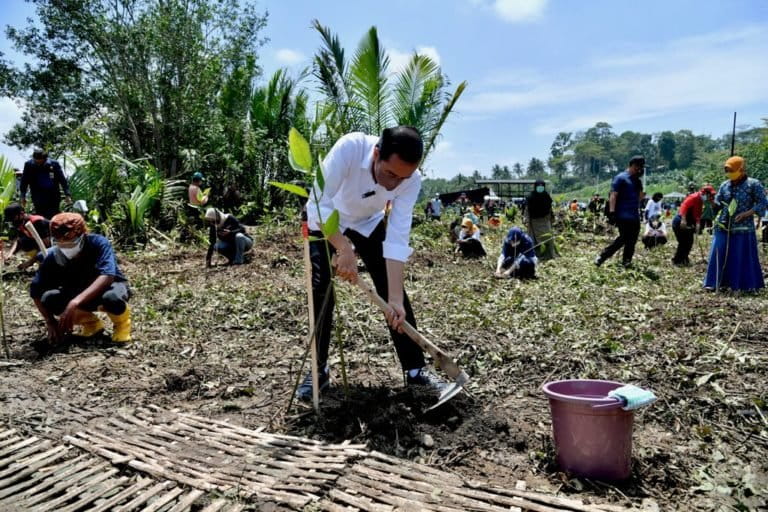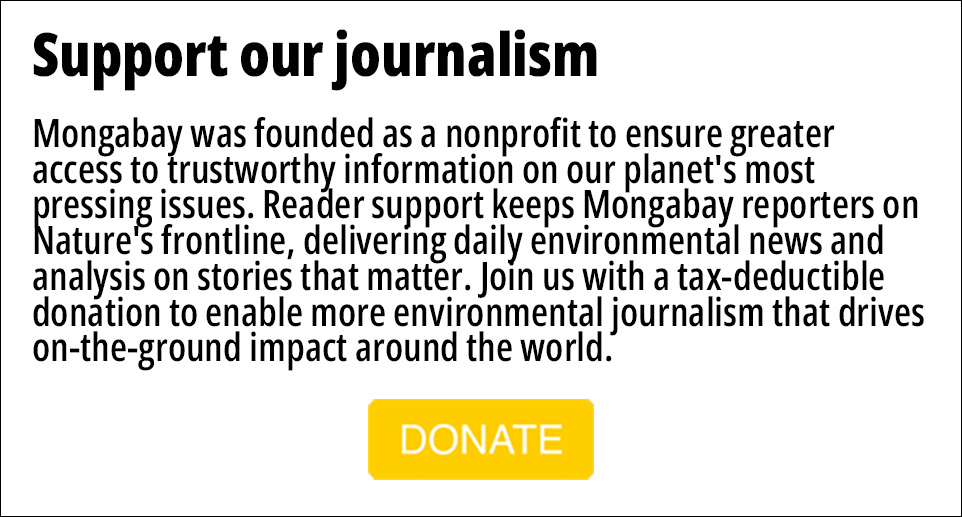
- Programs to restore areas of degraded tropical peatland and mangroves had mixed fortunes in their first year, with the former racing to 25% of its four-year target, and the latter achieving less than 6%.
- Officials and experts say a key obstacle to the mangrove restoration program is the opposition of the communities clearing the mangrove forests to establish shrimp and fish farms.
- Lack of funding was also an issue, with the mangrove budget slashed and redirected toward Indonesia’s COVID-19 pandemic response.
- Experts say the government needs to find a middle ground with shrimp and fish farmers, including by helping them boost their productivity so they can operate smaller farms and dedicate a greater area to rehabilitation.
JAKARTA — Indonesia has recorded mixed progress in its dual programs of restoring tropical peatlands and mangroves, acknowledging that achieving the latter goal will be far more challenging than for the higher-profile peatlands.
The government has targeted restoring 1.2 million hectares (3 million acres) of degraded peatlands and 600,000 hectares (1.5 million acres) of degraded mangroves by 2024, with both programs overseen by the Peatland and Mangrove Restoration Agency (BRGM).
In 2021, the first year for both programs, the BRGM recorded significant progress on peatlands, restoring 300,000 hectares (741,000 acres), or a quarter of the total. On the second goal, however, billed as the most ambitious mangrove rehabilitation program in the world, it managed to restore just 34,911 hectares (86,267 acres), or less than 6% of the total.
“There’s still a lot of work that we have to do until 2024, considering that our target is 600,000 hectares,” Satyawan Pudyatmoko, the BRGM deputy for planning and evaluation, said at a recent online event.
Both programs are crucial in Indonesia’s efforts to reduce greenhouse gas emissions; much of the country’s emissions come from deforestation and land-use change, including the clearing of peatlands for oil palm and pulpwood plantations, and mangroves for shrimp and fish farms.
Indonesia has the world’s largest area of tropical peatland, holding about 46 billion tons of carbon, and the largest extent of mangrove forest, which holds 3.1 billion tons. But the country has been losing both landscapes at alarming rates; a 2018 report by the Center on International Forestry Research (CIFOR) estimated Indonesia had lost 40% of its mangroves in the past three decades.

‘Not clean and clear’
The BRGM had initially targeted the restoration of 83,000 hectares (205,000 acres) of mangroves in 2021. But due to what it called “technical hurdles,” including the diversion of funding for the COVID-19 pandemic response, the government slashed the target to 33,000 hectares (81,500 acres), which it only just managed to surpass.
Kus Prisetiahadi, the deputy assistant for climate change to the chief maritime minister, said it was difficult to find areas of degraded mangrove that could be immediately rehabilitated without sparking opposition from local communities.
“So, on the map, [a potential site is] available, but sometimes, on the ground, it’s not clean and clear,” Kus said at the online event. “For instance, there may have been a change in land use and ownership [of the location].”
He said there needs to be an update to the mangrove map drawn up by the government, informed by field visits, to identify locations that are free from potential conflicts with landowners.
Muhammad Ilman, director of the oceans program at Yayasan Konservasi Alam Nusantara (YKAN), a Jakarta-based conservation NGO, said the most challenging of such sites are mangrove areas that have been converted by locals for shrimp and fish farms.
These also account for the vast majority, 83%, of degraded mangroves in Indonesia, Ilman added.
“Let’s say I have 10 hectares [25 acres] of fish and shrimp farms, and suddenly the BRGM comes to me and tells me they want to rehabilitate the mangroves,” he said at another recent online event. “Of course I’d say no, because I’d lose my fish and shrimp farms.”

Funding cut
Experts say silvofishery, the practice of cultivating mangroves alongside aquaculture farms, could be a solution to the problem of locals’ resistance. But even this might not work, Ilman said.
“Shrimp farms are an enclosed ecosystem. The leaves of mangrove trees in an open area become fertilizer [when they fall], but when they’re in an enclosed space, they become rotten,” he said, adding that this contaminates the water in the ponds, killing the shrimp and fish. “This is what makes shrimp farmers reluctant [to embrace mangrove rehabilitation].”
Another drag on restoring mangroves has been the budget cut for the program due to the COVID-19 pandemic, Kus said. The BRGM is now working with the Ministry of Environment and Forestry to develop a funding mechanism that can sustain both the peatland and mangrove restoration programs for years ahead, according to BRGM chief Hartono Prawiraatmadja.
One potential source of funding identified by the government is selling carbon credits to the private sector, he said.
“Many companies are proposing budget [for mangrove rehabilitation] to trade off emissions,” Hartono said. “Outside of carbon trade, there’s a lot of CSR [funding as well].”
He added the government is also pushing for mining companies to rehabilitate mangroves under their existing obligations to restore watershed areas impacted by their operations.

Restoration ‘at odds’ with community interests
While progress on restoring peatlands was far more successful in 2021, the program still faced the same challenge where “restoration efforts are often at odds with local people’s wishes,” said Tris Radityan, the BRGM deputy for construction and maintenance operations.
In some cases, he said, the areas of peatland targeted for restoration are located in areas already being cultivated by local communities.
Peatland degradation across Indonesia begins with draining the waterlogged, and carbon-rich, earth by digging canals. That leaves the land sufficiently dry for planting crops that would otherwise not be suitable in peat, such as oil palm. It also renders the dried-out peat layer a tinderbox that emits huge volumes of greenhouse gases and generates massive clouds of toxic haze when it’s burned, as is typically done prior to planting.
Restoring degraded peatland calls for blocking the canals to allow for the rewetting of the peat layer, which fundamentally undermines local communities’ interests, Tris said.
“Furthermore, these canals are also used for transportation, both for people and for harvest,” he added.

Continuing the restoration
This year, the government plans to restore another 300,000 hectares of peatlands and 228,200 hectares (563,800 acres) of mangroves.
The mangrove figure is nearly seven times the area restored in 2021. To achieve this boost, the BRGM says it will adopt a similar approach to peatland restoration, where it considers the entire landscape instead of focusing just on the areas with peat, and where it has to account for the land being used for different purposes.
“This is because a clearing in one location of a mangrove landscape will affect other locations,” BRGM chief Hartono said.
Within a mangrove landscape, the various land uses could range from silvofishery to ecotourism, Hartono added.
This way, the government will ensure that all stakeholders within that landscape, such as local communities and companies, can agree on and participate in the peatland and mangrove restoration programs, he said.
For silvofishery to be embraced by local communities, YKAN’s Ilman said, they should be allowed access to parts of the mangrove landscape reserved exclusively for shrimp and fish farming.
He said YKAN is currently trying this new method in a 10-hectare mangrove site in Berau district, East Kalimantan province. A fifth of the site is dedicated for shrimp farming, while the rest is being rehabilitated.
“In these 2 hectares, the locals can focus on shrimp farming without being bothered by the decomposing leaves from mangrove trees,” Ilman said. “Meanwhile, in the remaining 8 hectares, we let [the mangrove trees] grow and the water flow return to its natural state.”
While shrimp farmers would have to make do with less land under such a system, Ilman said they would still be able to maintain their livelihoods by adopting more productive farming techniques.
He cited cases in the Bornean provinces of North Kalimantan, East Kalimantan and West Kalimantan, where he said farmers typically harvest just 30 kilograms (66 pounds) of shrimp per hectare per year. “But if the farms are managed using technology like the ones in Java, a hectare can produce more than 20 [metric] tons,” Ilman added.
He said he hopes this approach can be replicated in other locations.
“If this [method] can become an example, most [degraded] mangroves can be rehabilitated back into mangroves and the people could continue their farming [business],” he said.
Banner image: Children rehabilitate mangrove in Indonesia. Image by Wahyu Chandra/Mongabay Indonesia.
FEEDBACK: Use this form to send a message to the author of this post. If you want to post a public comment, you can do that at the bottom of the page.
Indonesia on track with peatland restoration, but bogged down with mangroves
Source: Trends News


0 Comments